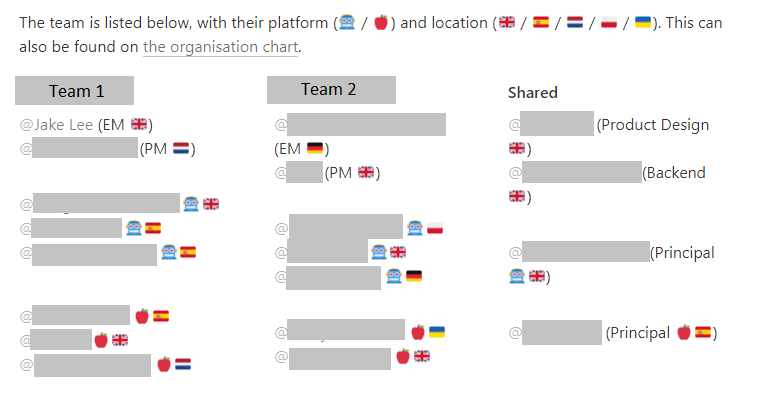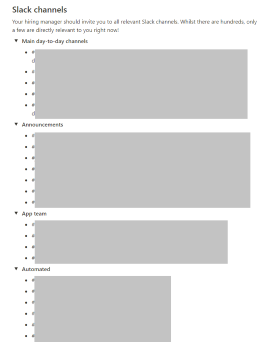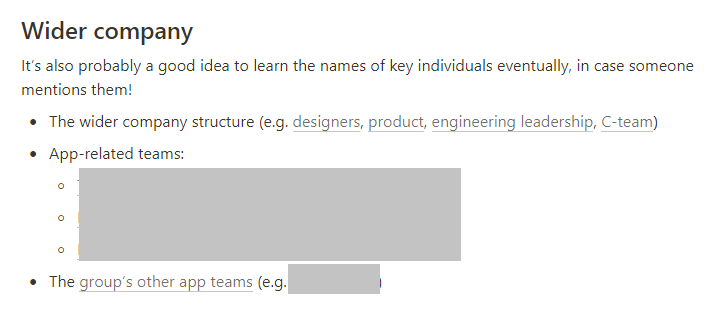
An example of onboarding process & documentation for remote developers joining a specialised team
Onboarding engineers to a project is hard. Especially if you’re in a small team (e.g. Android developers) without a whole HR framework, and instead have to make up your own processes! I’ve onboarded tens of engineers (and been onboarded of course), so here’s a few mistakes I’ve learned from, and my current preferred approach for onboarding new engineers.
Importantly, I am excluding all company-wide onboarding. For example, GDPR training, financial predictions, all of that is completely out of scope. I’ll only cover the onboarding into an actual software team, not the company itself.
Failed approaches
Before I get into the approach I went for, there’s been a few previous approaches that didn’t work too well:
Nothing structured
Although it wasn’t exactly planned… I’ve been on both sides of an essentially non-existent onboarding process. Whilst this isn’t the end of the world for more senior engineers who can hunt most information down themselves, more junior / quieter ones may struggle. A few months of drip-fed learning might transfer as much information as a week of planned onboarding.
This is probably the worst option possible, but the one most teams will fall into by default. Uh-oh!
Too many meetings
Having multiple, multi-hour “onboarding” calls / screen shares in the first few days ensured the new joiner was exposed to everything they needed… but did they absorb any of it? Whilst this is undoubtedly better than having no onboarding at all, it has a few risks.
I found new joiners totally understood everything whilst in the calls, but didn’t really retain much of it. A good example of this is technical onboarding: whilst having 1hr of general project architecture followed by 1hr of looking into the actual code is efficient, it’s overwhelming. The key points at the start will be totally lost by the end, regardless of how many notes the new joiner is making.
It’s also very hard for the new starter to refer back to missed bits and pieces later, besides asking someone to repeat themselves. This is a lot of wasted time and effort on both sides. Finally, new joiners are often focusing quite a bit on making sure their new employer / colleagues like them, so are socialising as much as learning. Not ideal!
Too much documentation
An alternative approach to this fully synchronous approach of all meetings is fully asynchronous: all documentation.
All teams struggle with documentation, but almost all have at least a “semi-useful” knowledge base / wiki / notion / confluence / etc. This can be leaned on heavily for onboarding new starters, and will ensure they have access to all information at any time, and can easily refer back to it.
The trade-off with this approach is essentially the opposite of too many meetings. Whilst the starter will have all the information they could ever need, they won’t know what they need to know. With a flood of hundreds of pages, how can the new starter know what they need?
I typically provided 5-10 “starter” pages for them, but this changed over time, and the documentation of course suffered all the usual issues of being out of date, unmaintained, misleading, etc. Additionally, this approach relies entirely on the joiner being very self-sufficient, finding out for themselves what they need to find out, etc.
Priorities
Okay, so I know what didn’t work. What should my approach have?
- Primarily (but not entirely) asynchronous: The joiner should be able to refer to information whenever they need to, but also be guided through a “narrative” of the app, and advised where to look.
- Always up to date information: The documentation should be useful for everyone, not just the new joiner. This way it’s in everyone’s best interests to maintain it.
- Guided, with flexibility: The new starter should never feel lost, but should have the freedom to dive deeper into areas that interest them.
Day by day
The onboarding should be guided, with a clear set of goals and information for each of the first few days. The engineering manager should always be available to answer any questions and schedule any 121 sessions, but won’t be needed every hour of every day.
Information like team members, office information, company systems are split into a day-by-day basis, and this is the main source for this information. As such, these pages are useful to (and maintained by) all existing employees too!
I used Notion for this, the platform doesn’t matter. I highly recommend giving Docs for Developers a read beforehand if possible, to make sure the knowledge is shared as effectively as possible.
Day 1: Product & Team
The first day isn’t at all technical, it’s all about the product itself and the team. As such, the goals are:
- Have access to all required systems (e.g. Slack, Email, JIRA)
- Know where & when to talk to people (e.g. team Slack channels, agile ceremonies)
- Have introductory sessions with Product & Design representatives.
Whilst this may seem like almost nothing on a first day, that’s by design! If the new joiner has capacity they can dive deeper into areas they want to get ahead on, or even just socialise more. There’s a million new things to learn, there’s no need to front-load all the information.
The introductory sessions should be organised by the hiring manager (who should be doing mini-checkins throughout), and will be covered in product and design. For asynchronous information, here’s the documentation included in Day 1:
Team
Everyone in the team, where they are, what they do, any other relevant information.
Emojis are great for making this a bit more friendly and compact, although be careful how many people you count as part of “the team”. We’re close to 20, and that’s definitely a limit. For ours, I tried to use horizontal space to represent different “sub-teams”, and vertical space to represent different “specialisms”:
Of course, this would be much tidier if everyone had similar length names, and I could figure out a clear emoji for “Product Design” or “Backend”! Linking to any official org chart also lets people “double check” the company’s structure, whilst also finding out who manages the managers etc.
Locations
Depending on how in-person your team is, office information might be essential. This doesn’t need to be a detailed history of the company offices etc, but each of our 3 locations have a page containing essential information:
- Floor plan: People forget where meeting rooms / bathrooms are!
- Facilities: If there is a gym, bike rack, shower, document them.
- Meeting rooms: How can a meeting room be booked? Where are they located?
- Building-specific info: If there’s a smoke alarm test every other Monday, document it. If there’s an entry door code, document it.
Systems
As mentioned, the new starter likely needs access to a surprising amount of company & team specific systems. Whilst many of these will be controlled by Single Sign On or other in-house systems, they still likely need documentation on how they work.
Even though most people will have experience with common systems like Firebase and JIRA, there will be specific quirks that should be documented. This might be how to gain access, how to workaround a bug, etc. Note that this documentation can (and should) be reused whenever non-team members also need basic training in a system.
The new starter probably won’t need these systems initially, but they should know what they are, what they do, and where they are.
Communication channels
Finally, they also need to know the formal and informal discussion areas. Teams often have a subteam channel, a speciality channel, a formal discussion channel, a casual discussion channel, and many, many more. New starters will often need 100+ channels, so a brief description & categorisation of these will help the newcomer know what can be safely muted!
Day 2: Engineering
Day 2 is more of a traditional “onboarding” session, with a focus on technical knowledge sharing.
The goals are:
- Have access to all necessary codebases.
- Understand the basic parts of the product.
- Have a local development environment setup, and can deploy the service / app / website locally.
I’d usually define Goal #1 as being in the organisation’s GitHub team, and can pull & push to all projects that need to be worked on. Codebase access will of course vary between organisations, and may take multiple days depending on security / IT.
For Goal #2, most of this will be done by a meeting with a senior or principal. Finally, Goal #3 may need descoping if a full local deployment isn’t realistic, as deploying locally can be a 5 minute or 5 hour job.
Day 3: Everything else
The final onboarding day is a bit of a “catch-all” for everything missed so far. The goal for this final day is nice and simple:
- New starter understands everything so far, and is ready to pick up their first (small!) ticket!
Further reading
A list of additional pages to read can help eager new joiners get ahead of the game, whilst also providing a clear list of “great” pages. For us, this was things like how to handle bugs, the app roadmap, how to handle queries from other teams, etc.
Processes
Whilst most companies use some form of agile, the new starter will likely need to be shown how the team handles things specifically. Ideally this will also be documented somewhere, but a session with an engineering manager (or agile coach / scrummaster) might help. Additionally, PR and release processes will need sharing.
Wider company
Often forgotten, the new starter probably needs to know people outside the current team!
For example, there will likely be teams that work closely with your team, your counterparts in sister companies, as well as of course all the senior management figures. It’s good to know where the “chain of management” goes, from the new starter all the way up to the CEO.
Misc notes
Finally, there’s a lot of information that’s just good to know. This might be finishing early during summer, the history of the team / product, or anything else. As this is the “everything else” of the “everything else”, it’s very flexible.
Onboarding sessions
Whilst most of the information will be asynchronous, actual handovers of information are still absolutely crucial. The specific make-up varies by company, but for us the three main entities during development are Product (e.g. Product Manager), Design (e.g. App UI Designer), and Engineering (e.g. Principal Android Engineer). All 3 of these key individuals have a unique perspective, and the combination of them should ensure the new starter gets a great overview.
Product session
A product manager often has the most complete view of the product, understandably so. This session should cover what the product does (e.g. Mission), where it currently is, and where it’s planning to go (e.g. Vision / Roadmap). Possible outcomes could be:
- New starter has in-depth understanding of the product, and understands the vision behind it.
- New starter knows what the company’s major upcoming features are, and how their team fits in.
- New starter understands how these features are planned, prioritised, and worked on.
Engineering session
This will likely be a typical onboarding to the codebase, software development practices, and overall approach. The basic outcomes of this could be:
- New starter knows the overall vision of the codebase.
- New starter understands the coding conventions followed.
- New starter is confident they can navigate the codebase themselves.
Design session
Whilst product and engineering may seem to be a complete picture, there’s often a role / individual in a team that has an outsized impact, and ends up representing the customer to some degree. In your company this might be a customer support representative, a quality engineer, or perhaps also a designer.
This session should show the product from a customer perspective, to help the new starter understand what the product is capable of, and why it feels and behaves the way it does. If this role is filled by design in your team, it will necessarily be a more visual session.
Possible outcomes could be:
- New starter knows all screens / areas of the product, and the current user flow.
- New starter understands how the design team works, and the tools they use for wireframing, prototyping, reviewing work etc.
- New starter can work effectively with design, knows how / when engineers are involved in feedback, how to raise design concerns, etc.
Improvements to make
Of course, this approach isn’t perfect. No approach is! However, it seems a bit better than the previous attempts, and hopefully it’s made new engineers have an easier transition into our team.
It’s crucial to factor in non-team onboarding throughout this process. If your company already has a structured onboarding for the first few days, it may not be worth starting your onboarding until a few days later. Contrastingly, if there is no wider onboarding (for payroll, customer support, everything else) you may need more than 3 days.
Whilst I’ve extolled the virtues of giving the new starter flexibility in when they learn new information, I think ideally the onboarding process would be slightly more structured. It’s often a challenge to fit the onboarding sessions around busy calendars, and it’s important the new starter doesn’t feel like they are a burden to existing employees.
Conclusion
Overall, I’m really happy with the day-by-day approach, and the flexibility it gives both the onboarder and the onboardee. However, itt’s definitely a tricky balance providing too much vs not enough information, and it needs personalising to the specific company, team, and even individual joining.
For example, I personally massively prefer reading information and being able to refer back to it, to the extent that things told to me in meetings are essentially forgotten unless I make notes! As such, this approach would suit me perfectly, as I could easily “read ahead” of the next day, remind myself who key individuals are, etc. However, for someone who prefers more conversations and discussions, it might be helpful to be “walked through” some of the information on a call. Catering the onboarding to the individual is a good way to ensure it all actually sinks in.
If you’ve tried the day-by-day onboarding style let me know how it went, otherwise I’m very interested in alternative approaches that might work better!


